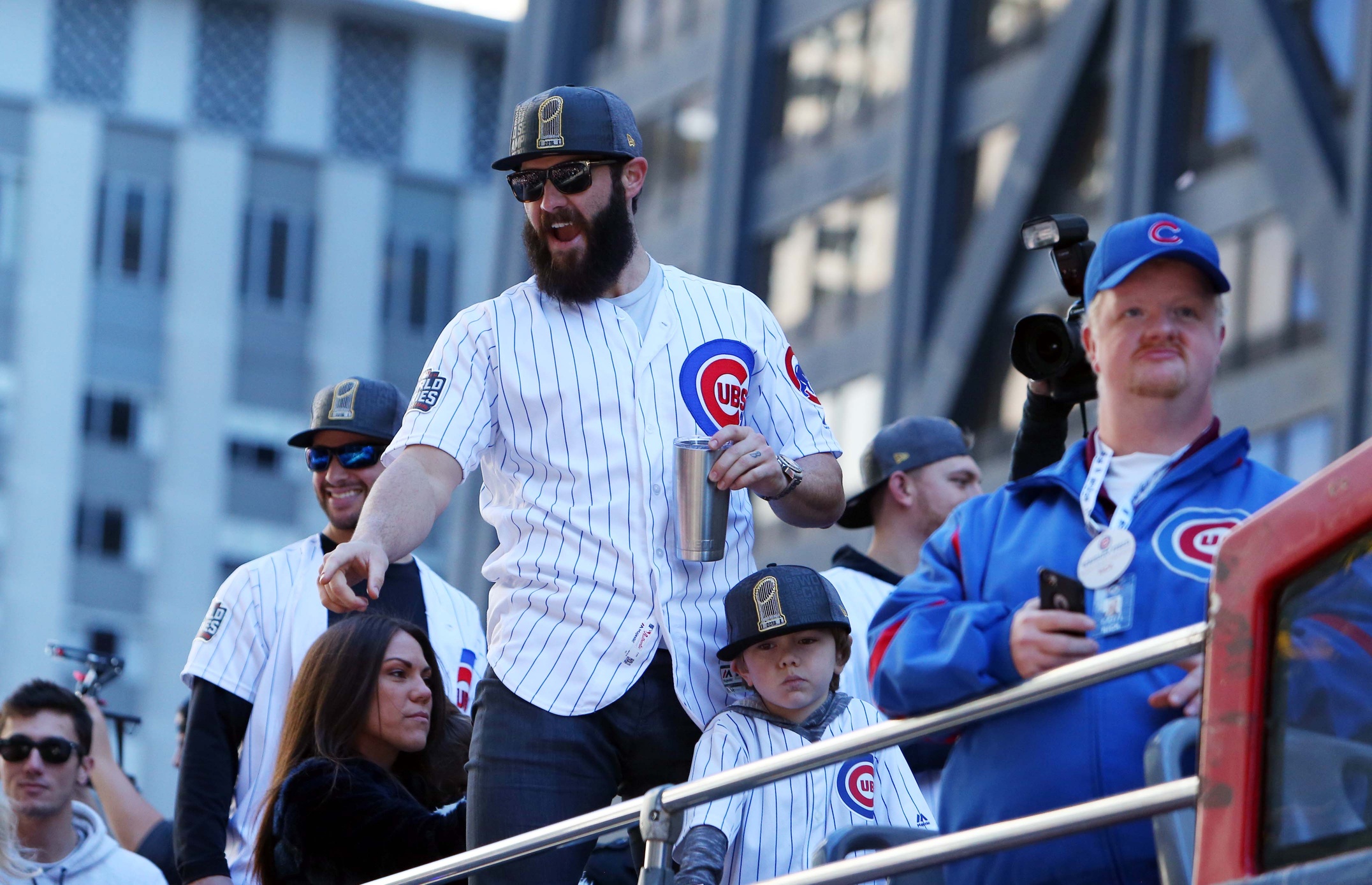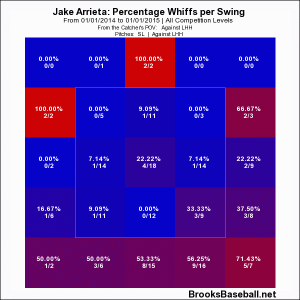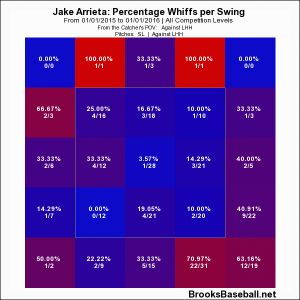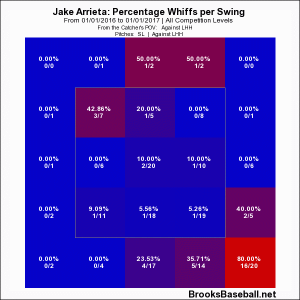Position: Starting pitcher
2016 Stats: 197.1 IP, 23.9 K%, 9.6 BB%, 3.10 ERA, 4.02 DRA, 3.0 WARP
Year in Review:
2016 was a banner year for the Cubs. Of course, I don’t simply mean that metaphorically — there will be a literal banner raised come April 2017 to celebrate the team’s first World Series championship in 108 years. But when looking at the achievements of each player individually, it’s easy to point out that 2016 actually wasn’t starting pitcher Jake Arrieta’s banner year — 2015 was. Well, maybe no banner was actually involved, but a trophy of the Cy Young sort was.
We know the facts, 2015 and specifically the second half of it brought Arrieta to national prominence in baseball’s version of a rags-to-riches type story. “I’m thinking about not playing anymore after this season,” was what Arrieta said back when he was the Orioles version of himself back in 2013, which seems far away from the version of Arrieta seen today.
But baseball is a game of odds, and the odds of Arrieta repeating his historic run from 2015 were next to impossible, and not just by Arrieta, but by anyone in the sport for likely a very long time and certainly not in 2016. Regression was knocking at Arrieta’s door, and he knew he had no choice but to let it in. The thing is, any good baseball minded person understands that that’s just how the sport works, and that regression in this context is okay. It’s natural.
Arrieta still finished 2016 with an ERA in the top 15 in baseball, and the top 10 among the National League (min. 150 IP). He struck out just under a quarter of batters he faced, which was a slight drop off from his 27.1 percent mark in 2015 — but really, it’s best not attempting to compare history to a solid season’s effort at every turn of the coin here.
Arrieta still flourished in all the important statistical categories in 2016, however walks were the main issue Arrieta faced in 2016. Arrieta walked 9.6 percent of batters he faced in 2016, which is something he hasn’t done since 2013, a season in which he was still in Baltimore walking 12.1 percent of batters.
Walks come from a lack of control, not having enough swing and miss stuff, and not being able to locate pitches where you’d like them, thus leaving them more viable to allow contact. In a good pitcher, a pitcher with a strong track record, those things usually stem from poor mechanics. More on that later.
Arrieta’s plate discipline numbers stayed virtually the same from 2015 to 2016, and his BABIP actually dropped just a tad, going from .246 in 2015 to .241 in 2016. Take a look at some of the PITCH f/x data on Arrieta from 2015 to 2016:
| O-Swing | O-Contact | Swing | SwStrike | |
| 2015 | 32.8 | 62.3 | 47 | 10.5 |
| 2016 | 29.9 | 63.3 | 45.3 | 9.1 |
There’s a lot more where that came from, but the main thing to focus on here is that batters stopped swinging as much at pitches outside the zone, while making contact on them just a bit more. Batters also swung less at Arrieta’s stuff overall, and racked up less swinging strikes. All this indicates that the pitches these batters saw from Arrieta likely weren’t entirely as deceptive as they needed to be.
What does all of this mean? Perhaps Arrieta wasn’t as sharp in 2016 as he had been in 2015, leading to a conclusion that was whispered around baseball as soon as Arrieta faced struggles — what if his mechanics from Baltimore, the ones that nearly destroyed his chance at being a successful pitcher, were making their way back into his repertoire? We’ve done quite a bit of coverage this season at BP Wrigleyville on Arrieta’s mechanics in 2016, and now that we have a full season in the books in which virtually the only thing to have changed so drastically is the rate at which Arrieta gave up home runs and the spike in his walk rate, two things which are often linked to mechanical difficulties, it’s safe to say that this was likely the cause for Arrieta’s regression in 2016.
One of the major contributors to Arrieta’s walk rate was hidden in his splits. Take a look at how Arrieta’s walk rate has differed in his three seasons on the North Side:
| LHH | RHH | |
| 2014 | 8.2% | 5.4% |
| 2015 | 6.6% | 4.6% |
| 2016 | 13.6% | 5.9% |
The spike in 2016 was drastic, and it seemed due in part to the fact that his slider just wasn’t as effective against opposite handed hitters this season as it had been in the past. Another issue that could stem from improper mechanics. Take a look at the whiff per swing maps for Arrieta from 2014, 2015, and 2016.
Left handed hitters were whiffing less on their swings in 2016 than in any of the three previous years, leading to the spike in Arrieta’s walk rate.
To say Arrieta’s 2016 was a successful follow up to his untouchable 2015 is certainly a truism, but to say that there weren’t a few red flags hidden from the very beginning is just blatantly ignoring what could become a budding problem for a pitcher who is likely to hit free agency in 2018.
Looking Ahead:
Early in 2016, I wrote about how I felt that it was too early for either side to agree to an extension for Arrieta just yet. Both Arrieta and the Cubs’ front office needed to let the dust settle from the 2015 and see in his third season as a shiny new ace what Arrieta would do. The results of 2016 were is exactly why I felt that way.
Arrieta is of course still a top pitcher in baseball, and will become a highly coveted free agent in 2018 should the Cubs not extend him. But mechanical issues are nothing to be trifled with. Though we understand that Arrieta is a master of his health and taking care of his body, including being a pilates wizard and a connoisseur of every green drink known to man, mechanics are one of the top issues a pitcher can face that could end up leading to career ending injuries. On a less dramatic scale, as Arrieta saw in Baltimore and hinted at this past season, poor mechanics can also be the culprit in poor performances on the mound that don’t always lead to injury, but simply lead to things like control issues that lead to walks, mislocating pitches that lead to balls being squared up or hit for hard contact, etc.
Arrieta has been aware that he wasn’t fully in sync in 2016. “I’m resilient, I’ll bounce back. I’ll get to the point where I was early in the season and last year soon. This won’t continue. It’s frustrating it has gone for this long of a period. We’ll make it right.” Arrieta said back in July. That’s the first step to repairing any problem.
It’s unlikely that Arrieta will wander back down the path he was on in Baltimore though; he’s come too far, reconciled too many issues, found a strong mental and physical regimen, and has too strong of a coaching staff to let himself become that far gone again. But what 2016 has proven is that old habits truly die hard, and whatever small aspect of Arrieta’s focus and mechanics that worked so well in concert for him in the past that was derailed, he needs to get it back in order to stay as sharp a he has now shown the baseball world that he can be.
Arrieta is not likely to fall off a cliff, but nipping problems like this in the bud before he does is important for his future, and for baseball.
Lead photo courtesy of Jerry Lai—USA Today Sports



